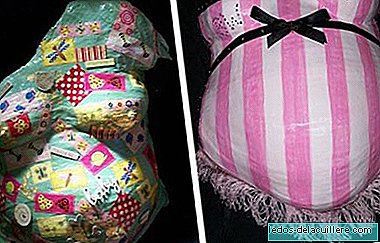The skin is the largest organ of the human body and when we wait for a baby we want to know how it will look. We often ask ourselves, How is the skin of the newborn? Beyond the color there are certain characteristics that we are going to approach to know a little more about its delicate dermis.
Upon birth, the baby's skin is covered with a sebaceous substance called vernix caseosa, whose function inside the uterus was to protect the baby's delicate skin. This function can continue for a few more hours when the baby is born, but in the hospital they usually clean it.
Your skin is usually wrinkled having been in contact with the amniotic fluid for nine months and since he has not received direct light, his skin appears reddish or bruised while acclimatizing to his new world. Before the baby breathes for the first time with that initial crying the skin darkens.
In the first few days, in addition, as the temperature changes affect it (it is one of the main changes the newborn faces), you will see that your skin changes if it is exposed to a low ambient temperature, turning to those tones reddish or bluish. By the second or third day of the baby's life, the skin clears a little and can become dry and flaky, as we will see below.
It is important that the baby does not lose temperature and his skin cools, placing a hat and especially being in contact with the mother's body, skin with skin, to transmit our heat, our smell, our touch.
Another of the characteristics of the skin of many newborns It is the presence of lanugo, a fine and soft hair that can cover the scalp, forehead, cheeks, shoulders and back. It is more common in premature babies and should disappear in the first weeks of the baby's life.
Depending on the gestation time, other differences in the baby's dermis can also be observed. Premature babies have thin and transparent skin, while a full-term baby's skin is thicker. In any case, the skin of an adult person is much thicker.
Due to its fineness since the ratio of the body surface to weight is greater than in adults, the baby's skin has greater permeability to many substances that could be harmful and the effect of the sun, so you have to take care of the skin and protect it especially.
The underdeveloped defensive mechanisms and the special acid characteristics of the baby's dermis make it more exposed to infectious agents.

Frequent changes in the skin of the newborn
It is normal and frequent desquamation of the baby's skin, physiological. It occurs mainly in wrists, backs of hands and feet, knees and in some cases in the chest. We can use some specific lotion or oil to hydrate the dermis, taking into account that we should not abuse cosmetic products for the baby.
Jaundice happens when the baby's skin turns yellow as a result of the proper non-elimination of bilirubin. It also produces a coloration of the eyes and occurs in many newborns after 48 hours of life and is reduced thanks to phototherapy. It is a transient and normal process that usually disappears after about ten days, more frequent in premature children.
Milium are white granites that appear on the face of the newborn. These are small fat cysts that can appear alone or grouped in the area of the forehead, cheeks, nose and chin. These granites, which should not be squeezed or tried to remove, disappear spontaneously between the month and three months and life.
The allergic toxic erythema or urticaria of the newborn are red granites, similar to hives, which disappear during the first week. It is a common and benign rash.
Simple flat or snowy angiomas, reddish spots (also known as "the angel's kiss" and the "stork bite"), which appear on the nose, eyelids or neck and disappear about six months or later if They are very marked. They are dilated and congested blood capillaries that are marked a lot by being very close to the surface.
We hope with this summary to have known a little more how is the skin of the newborn, its characteristics and its most frequent alterations. Now we just have to wait to see if it will be a dark or light-skinned baby.
Photos | Lisa Rosario on Flckr-CC and Thinkstock
In Babies and more | Ten changes in the skin of the newborn, Five tips for caring for the skin of the newborn, Cosmetic products for the baby's skin? The essentials












